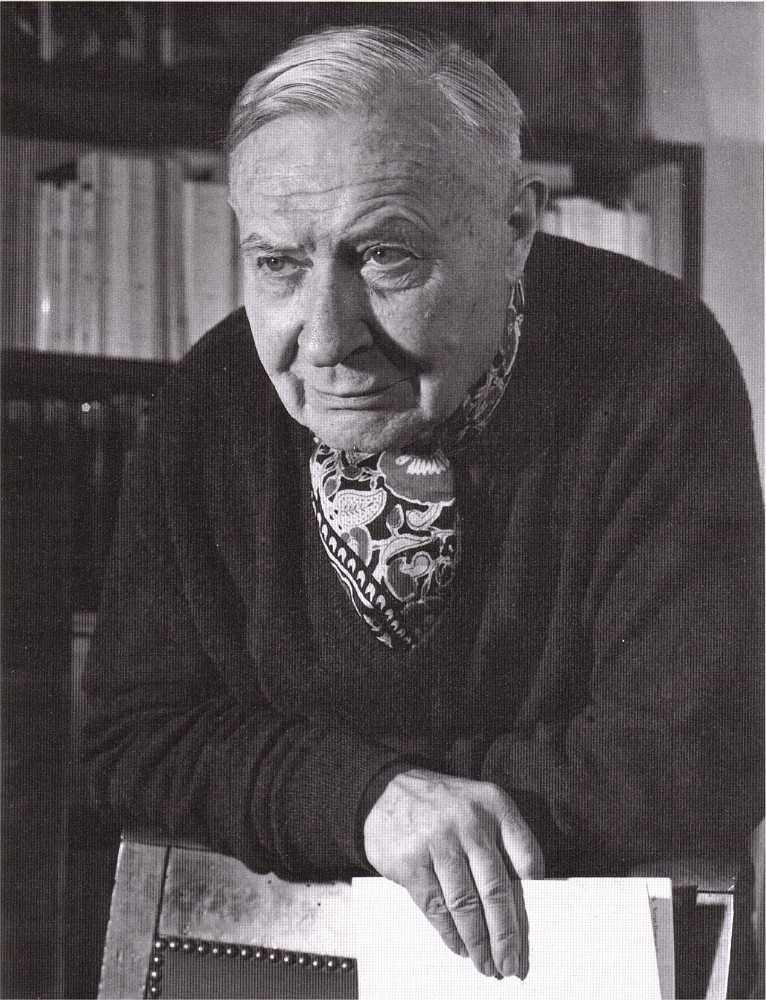БИБЛИОГРАФИЯ
- Европейское искусство. Живопись. Скульптура. Графика. Энциклопедия. — Т.2. — М.: Белый город, 2006
- Лесли Р. Сюрреализм. Минск, 1997
- Carmine Benincasa «André Masson – L’universo della pittura» – Ed. Mondatori, Milano 1989
- René Passeron « André Masson et les puissances de signe », Denoël 1975
- Stephan Moebius « Die Zauberlehrlinge. Soziologiegeschichte des Collège de Sociologie », Konstanz, 2006
- Jean-Clarence Lambert,« André Masson », Paris, éd. Filipacchi, 1979
- Daniel Guérin « Eux et Lui. suivi de commentaires, ornés de cinq dessins originaux d’André Masson ». Lille, 2000
При написании этой статьи были использованы материалы таких сайтов: ru.wikipedia.org, , , ,
Творчество. Свобода. Живопись.
Allpainters.ru создан людьми, искренне увлеченными миром творчества. Присоединяйтесь к нам!
Проголосуйте page
БИОГРАФИЯ ХУДОЖНИКА
Родился в Баланьи-сюр-Терен (Бельгия) 4 января 1896 в семье директора школы. Детство его прошло в Брюсселе.
В 1908 окончил курсы рисования при Брюссельской школе художественной вышивки и поступил в местную Академию художеств.
В 1912 продолжил учебу в парижской Школе изящных искусств. В начале Первой мировой войны пошел на фронт добровольцем и был тяжело ранен (1917). Жил преимущественно в Париже, первоначально зарабатывая на жизнь в качестве керамиста и газетного корректора.
Заключив контракт с известным галеристом Д.-А.Канвейлером, смог с середины 1920-х годов целиком посвятить себя искусству. В ранних его вещах проявляется сильное влияние красочно-символистской манеры Дж.Энсора. Прошел также через период кубизма. Нашел себя в русле сюрреализма, познакомившись после первой своей персональной выставки (1924) с А.Бретоном.
Умер Массон в Париже 28 октября 1987.
The serenity of Aix
Returning to France in October 1945, Masson lived for some time in Lusignan, near Poitiers, but kept a close link with Paris, designing in 1946 the sets for Hamlet (at the Théâtre Marigny for the Compagnie Renaud-Barrault, music by Arthur Honegger) and La Putain respectueuse (by Jean-Paul Sartre, at the Théâtre Antoine).
Discovering Provence following an invitation from René Char to participate in an exhibition in Avignon, Masson settled in 1947 in Le Tholonet, near Aix-en-Provence, at the foot of the Sainte-Victoire mountain.
A new period began for him, punctuated by walks, readings and visits to friends, thus relatively calm compared to what he had experienced until then. In 1950, he published Le plaisir de peindre. His style softened considerably, to the point that he showed an interest in Impressionism: in 1952, he published an article in the magazine Verve entitled “Monet the Founder” in which he established a Turner-Monet-Renoir-Cézanne filiation and in which, praising Monet”s Water Lilies, he wrote: “I am very seriously pleased to say that the Tuileries Orangery is the Sistine Chapel of Impressionism.
The titles of the paintings systematically evoke his relationship to the landscape (Bibemu”s quarry, The countryside of Aix in November, Mountain after the rain, The Mistral…), his “Aix period” is often disdained by critics.
Художественные работы
Его ранние работы показывают интерес к кубизму . Позже он стал ассоциироваться с сюрреализмом , и он был одним из самых увлеченных работодателей , сделав ряд автоматических работ пером и тушью. Массон экспериментировал с измененными состояниями сознания с такими художниками, как Антонен Арто , Мишель Лейрис , Жоан Миро , Жорж Батай , Жан Дюбюффе и Жорж Малкин , которые были соседями его мастерской в Париже.
Примерно с 1926 года он экспериментировал, набрасывая песок и клей на холст и создавая картины маслом на основе образовавшихся форм. Однако к концу 1920-х годов автоматическое рисование стало для него довольно ограничивающим, и он оставил сюрреалистическое движение и вместо этого обратился к более структурированному стилю, часто создавая работы на жестокую или эротическую тему. Он жил в Испании в начале Гражданской войны , что отражено в ряде его картин (в конце 1930-х годов он снова связался с сюрреалистами).
Во время немецкой оккупации Франции во время Второй мировой войны его работа была осуждена нацистами как вырожденческая . С помощью Вариана Фрая в Марселе Массон бежал от нацистского режима на корабле на французский остров Мартиника , откуда он отправился в Соединенные Штаты. По прибытии в Нью-Йорк таможенники, осматривавшие багаж Массона, обнаружили тайник с его эротическими рисунками. Живя в Нью-Престоне, штат Коннектикут, его работы оказали большое влияние на американских абстрактных экспрессионистов , таких как Джексон Поллок.. После войны он вернулся во Францию и поселился в Экс-ан-Провансе, где написал ряд пейзажей .
Массон нарисовал обложку первого номера журнала Жоржа Батая , Acéphale , в 1936 году и участвовал во всех его выпусках до 1939 года. Его шурин, психоаналитик Жак Лакан , был последним частным владельцем Гюстава Курбе » провокационная картина L’Origine du monde ( «Происхождение мира» ); Лакан попросил Массона нарисовать сюрреалистический вариант.
Библиография
- Паскаль Пиа, Андре Массон, Париж, Галлимар, коллекция «Новые скульпторы», 1930.
- Андре Массон, опубликованный по инициативе Роберта Десноса и Арманда Салакроу в 1940 году (ограниченное издание без названия издателя). Каждая копия подписана Андре Массоном. Текст Жан-Луи Барро, Жорж Батай, Андре Бретоном, Деснос, Поль Элюар, Армель Guerne, Пьер Жан Жув, Мадлен Ландсберг, Лейрис, Джорджес Лимбор, Бенжамен Пере . Переиздан в 1993 году изданием André Dimanche в Марселе.
- Жорж Лимбур и Мишель Лейрис Андре Массон и его вселенная, Лозанна, Les Trois Collines, 1947.
- Жорж Лимбур, Андре Массон, рисунки, коллекция «Plastique», Париж, изд. Браун, 1951 год.
- Андре Массон, Интервью с Жоржем Шарбонье, предисловие Жоржа Лимбура, Париж, Жульяр, 1958; переиздание Марсель, Издательство Андре Диманш, 1995.
- Даниэль Герен, Eux et Lui, сопровождаемый комментариями, украшенный пятью оригинальными рисунками Андре Массона, Монако, Издательство дю Роше, 1962; переиздать QuestionDeGenre / GKC, 2000.
- Юбер Жуен, Андре Массон, Карманный музей, Париж, 1963.
- Андре Бретон, Le Surréalisme et la Peinture, Париж, Эд. Галлимар, 1965.
- Жан-Клод Клебер, Мифология Андре Массона, Женева, изд. Пьер Кайлер, 1971 год.
- Франсуаза Уилл-Левайан, Андре Массон, азиатский период 1950-1959 годов, Париж, Galerie de Seine, 1972.
- Андре Массон, La Mémoire du monde, Genève, Skira, 1974 (интервью с Гаэтаном Пиконом).
- Андре Массон, Le Vagabond du surréalisme, интервью с Жильбертом Браунстоуном, Париж, Эд. Сен-Жермен-де-Пре, 1975 год.
- Роджер Пассерон, Андре Массон и сила знаков, Деноэль, 1975.
- Андре Массон, Le Rebelle du Surréalisme, Париж, Эд. Герман, 1976 (антология, составленная Франсуазой Левайан); переиздание в 1994 году.
- Жан-Кларенс Ламбер, Андре Массон, Париж, Эд. Филипаччи, 1979.
- Хосе Пьер, Сюрреалистическое приключение вокруг Андре Бретона, Париж, Эд. Филипаччи, 1986.
- Флоренс де Мередье, Андре Массон, автоматические чертежи, Blusson, 1988.
- Андре Массон, Сюрреалистические годы. Корреспонденция 1916-1942, Лион, Ла Мануфактура, 1990 (издание, составленное и представленное Франсуазой Левайан после докторской степени Ф. Левайяна, Андре Массон: Lettres choisies 1922-1942, Парижский университет I, Пантеон-Сорбонна, 1986).
- Мишель Сурья, Жорж Батай, смерть на работе, Париж, Галлимар, 1992; тростник. колл. «Тел», 2012.
- Бернар Ноэль, Андре Массон, плоть уважения, Париж, Галлимар, колл. «Искусство и писатель», 1993.
- Masson et Bataille, Musée des Beaux-Arts d’Orléans, муниципальный музей Тосса-де-Мар, 1994, тексты Эрика Муане, Андре Массона, Бернара Ноэля, Глории Бош, Терезы Грандас.
- Дон Адес, Андре Массон, Париж, Эд. Альбин Мишель, колл. «Великие мастера современного искусства», 1994 (перевод с английского Жака Транье).
- Франсуаза Левайян, Резня знаков, Токио, Мисузу Шобо, 1995.
- (автор) Стефан Мебиус, Die Zauberlehrlinge. Soziologiegeschichte des Collège de Sociologie, Констанц, 2006.
- Армель Герн, Андре Массон или другие ценности, Les Amis d’Armel Guerne asbl, 2007 (некоммерческое издание).
- (en) Кларк В. Полинг, Андре Массон и сюрреалистическое Я, Нью-Хейвен и Лондон, издательство Йельского университета, 2008.
- Андре Массон. Резюме каталога живописных работ, 1919-1941, Vaumarcus, Editions ArtAcatos, 2010; каталог, составленный Гите Массон, Мартином Массоном и Кэтрин Лёвер, предисловие Бернара Ноэля, «Андре Массон» Дон Адес, «Биография Андре Массона (1896-1941)» Камиллы Морандо.
- Винсент Тейшейра, «Глаз в действии -« История глаза »и его художники», Cahiers Bataille, № 1, Meurcourt, Éditions les Cahiers, 2011.
- Элен Парант, Фабрис Флаутес, Камилла Морандо, библиотека Андре Массона. Археология, Париж, Artvenir, 2011 ( ISBN ) .
ИНТЕРЕСНЫЕ ФАКТЫ ИЗ ЖИЗНИ ХУДОЖНИКА
В апреле 1917 года он тяжело раненый лежал всю ночь посреди кровопролитной битвы при Эсне на Дороге Дам, пока на следующий день до него смогли добраться санитары. Ранение в грудь было настолько серьезным, что Массону пришлось провести в госпиталях два года, а последствия контузии привели его даже в психиатрическую лечебницу. Всю жизнь Массона продолжали мучить физические боли, ночные кошмары и бессонница. Доктор, который лечил Массона, настоятельно рекомендовал ему избегать больших городов и стараться соблюдать покой. Массон следовал этим рекомендациям с переменным успехом – он довольно часто жил в Париже, периодически отправляясь в провинцию или за границу. По легенде, его мать–найденыш была цыганского рода, чем друзья и объясняли его частые передвижения и смены адресов.
В 1941 году Андре Массон с семьей был переправлен в США. На границе таможенники прямо на его глазах разорвали пять рисунков, приняв их за порнографию.
The beginnings
André Masson was born on June 4, 1896 in Balagny, a village located about thirty kilometers from Beauvais, in the Oise region, the son of a wallpaper salesman. His family moved to Lille in 1903, then to Brussels two years later, and he trained as a painter from an early age, studying at the Royal Academy of Fine Arts from 1907 to 1912. He learned mural decoration and received a first prize for decoration. His first artistic emotion came from the discovery of James Ensor”s paintings, of which he said later that he appreciated this painter all the more because he was “considered a lunatic by his time”.
One of his teachers introduced him to the work of the poet Emile Verhaeren and persuaded his parents to have him continue his education in Paris. In 1912, he left Belgium and enrolled in the studio of the fresco artist Paul Baudoüin at the École Nationale des Beaux-Arts until April 1914. After a trip to Tuscany on a scholarship, he went to Berne, Switzerland, and joined the infantry a year later. He was seriously wounded in the chest during the Chemin des Dames offensive in April 1917, and for a time was left for dead in a bomb crater. He stayed in various hospitals until the Armistice. From this war, he kept all his life a repulsion for warmongering and translated it in several of his works, including the Massacres, in 1934.
After the war, Masson stayed for a while in an abandoned hut on the shore of the Etang de Berre, near Martigues (not far from Marseille), then went to Collioure, following in the footsteps of Matisse and Derain, and then to Céret, in the Pyrénées-Orientales, near the Spanish border, where he was influenced by both Cézanne and van Gogh (Paysage de Céret, Environs de Céret). He moved there in April 1919 and met the painter Chaïm Soutine. The following year, he married Odette Cabalé (1899-1984), a native of the town. After the birth of their daughter, the family moved to Paris, in the district of Montmartre.
Summary
André Masson, born January 4, 1896 in Balagny-sur-Thérain (Oise) and died October 28, 1987 in Paris, is a French painter, engraver, illustrator and decorator of theater.
He participated in the Surrealist movement during the 1920s and kept the spirit of it until 1945. In a more marginal way, he also practiced sculpture.
Famous for his “automatic drawings” and his “sand paintings”, he is marked – on an aesthetic level – by “the spirit of metamorphosis” and “mythical invention” and even more – on an ethical level – by a visceral anti-conformism, including within the surrealist group from which he moves away as soon as he enters and that he denounces as “orthodox”; appearing there as a “rebel” or a “dissident”.
Having narrowly escaped death during the First World War and sensitive to the writings of Sade and his friend Georges Bataille, his work can be interpreted as an uncompromising questioning of human barbarism and perverse behavior. This preoccupation taking precedence over any aesthetic consideration, critics explain the marginal role he plays in modern art by the fact that “he has never been concerned with pleasing”.
His influence was most noticeable in New York during World War II, where he was staying while fleeing Nazi Germany. His paintings broke with the classical scheme of figures standing out against a background (in order to best symbolize the state of mental confusion that – according to him – governed his century), and served as references to the painters Jackson Pollock and Arshile Gorky, founders of abstract expressionism.
On the other hand, the last forty years of his career (from the time of his return from the United States) are generally shunned by the critics.
Библиография
- Андре Массон. Каталог raisonné de l’œuvre peint, 1919–1941. Vaumarcus: Éditions ArtAcatos, 2010. Каталог Гите Массон, Мартин Массон и Кэтрин Лёвер, предисловие Бернара Ноэля, «Андре Массон» де Дон Адес, Биография д’Андре Массона ( 1896–1941) Камилла Морандо.
- Андре Массон. Опубликовано по инициативе Роберта Десноса и Арманда Салакру в 1940 году (ограниченное издание анонимного издателя). Каждая копия подписана Андре Массоном. Текст: Жан-Луи Барро, Жорж Батай, Андре Бретон, Роберт Деснос, Поль Элюар, Армель Герн, Пьер Жан Жув, Мадлен Ландсберг, Мишель Лейрис, Жорж Лимбур, Бенджамин Перет. Перепечатано в 1993 г. издательством Éditions André Dimanche в Марселе.
- Dawn Ades. Андре Массон. Коллекция Les grands maîtres de l’art contemporain. Париж: Éditions Albin Michel, 1994. (Перевод с английского Жака Транье).
- Андре Бретон. Le Surréalisme et la Peinture. Paris: Éditions Gallimard, 1965.
- Жан-Клод Клебер, Mythologie d’André Masson. Женева: Издания Пьера Кайлера, 1971.
- Даниэль Герен. Eux et Lui. suivi de commentaires, ornés de cinq dessins originaux d’André Masson. Лилль: 2000.
- Армель Герн. Андре Массон или Les Autres valeurs. 2007.
- Юбер Жуин. Андре Массон. Париж: Le musée de poche, 1963.
- Жан-Кларенс Ламбер. Андре Массон. Paris: Éditions Filipacchi, 1979.
- Françoise Levaillant. Massacre de signes. Tokyo: Misuzu Shobo, 1995.
- Жорж Лимбур и Мишель Лейрис Андре Массон и сын универс. Лозанна: Les Trois collines, 1947.
- Жорж Лимбур Андре Массон, рисунки. Коллекция «Пластик». Париж: Éditions Braun, 1951.
- Андре Массон. Entretiens avec Georges Charbonnier, preface de Georges Limbour. Париж: Джульярд, 1958. Перепечатано в 1995 году издательством André Dimanche, Марсель.
- Андре Массон. La Mémoire du monde. Женева: Скира, 1974 (беседы с Гаэтаном Пиконом).
- Андре Массон. Le Vagabond du surréalisme. (беседы с Гилбертом Браунстоуном). Paris: Éditions Saint-Germain-des-Près, 1975.
- Андре Массон. Le Rebelle du Surréalisme. Париж: Издания Hermann, 1976. (Anthologie établie par Françoise Levaillant). Перепечатано 1994.
- Андре Массон. Les Années surréalistes. Переписка 1916–1942 гг. Lyon: La Manufacture, 1990. (établie et présentée par Françoise Levaillant, d’après le Doctorat de F. Levaillant, «André Masson: Lettres choisies 1922–1942». Université de Paris I, Panthéon-Sorbonne, 1986). 40>
- Андре Массон. «Диссонансы». В Антологии X. Оксфорда и Нью-Йорка: Oxford University Press, 1988. «X журнал», Vol. I, No. III (июнь 1960)
- Florence de Mèredieu. Андре Массон, автоматические рисунки. Blusson, 1988.
- Стефан Мебиус. Die Zauberlehrlinge. Soziologiegeschichte des Collège de Sociologie. Констанс :, 2006.
- Бернар Ноэль. Андре Массон, председатель правления. Коллекция l’art et l’écrivain. Paris: Gallimard, 1993.
- Рене Пассерон. Андре Массон и другие власти. Denoël 1975.
- Хосе Пьер, «L’Aventure Surréaliste autour d’André Breton», Париж, изд. Filipacchi, 1986.
- Кларк В. Полинг. Андре Массон и сюрреалистическая личность. Нью-Хейвен и Лондон: Издательство Йельского университета, 2008.
- Мишель Сурья. Жорж Батай, la mort à l’œuvre. Paris: Gallimard, 1992.
- Françoise Will-Levaillant. Андре Массон, азиатский период 1950–1959 годов. Париж: Galerie de Seine, 1972 г.
- Бухгольц, Кай и Клаус Вольберты (ред.). Андре Массон. Фотографии из Labyrinth der Seele. Франкфурт а. М.: 2003.
- Kaiser-Strohmann, Dagmar. Vom Aufruhr zur Struktur. Schriftwerte im Informel, каталог выставки: Gustav-Luebcke-Museum Hamm 2008. ISBN 3-9807898-6-1.
- Мюллер-Яо, Маргарита Хуэй. Der Einfluss der Kunst der chinesischen Kalligraphie auf die westliche informelle Malerei. Дисс. Bonn, Koeln 1985. ISBN 3-88375-051-4.
- Мюллер-Яо, Маргарита. «Informelle Malerei und chinesische Kalligrafie». В Informel, Begegnung und Wandel, под редакцией Хайнца Альтофера. Schriftenreihe des Museums am Ostwall 2. Dortmund :, 2002. ISBN 3-611-01062-6.
- Рольф Ведевер. Die Malerei des Informel. Weltverlust und Ich-Behauptung. Мюнхен: Deutscher Kunstverlag, 2007. ISBN 3-422-06560-1.
- Carmine Benincasa. Андре Массон — L’universo della pittura Milan: Editore Mondatori, 1989.
The flight and the exodus
In June 1940, all of northern France was occupied. Masson, his wife (of Jewish origin) and their sons fled to the Cantal, in the free zone.
In October, when the status of the Jews was published, they decided to go to Marseille with the idea of going to America. With the help of Countess Lily Pastré, they occupied an isolated pavilion on the outskirts of the city, waiting for a visa to the United States, which they obtained in March 1941. In the meantime, Masson attended meetings at the Villa Bel Air, which welcomed writers and artists who were on the verge of exfiltration thanks to the American journalist Varian Fry, creator of the American Committee for Intellectual Relief. With the financial help of a Jewish family of wealthy Baltimore art collectors (the sisters Saidie May and Blanche Adler), they embark for the new continent.
After a three-week stay in Martinique, where he met the poet Aimé Césaire and marveled at the lush vegetation, Masson went to the United States in May 1941. He settled first in New York (where he met other European intellectuals and artists, including André Breton and Marcel Duchamp) and then in New Preston, Connecticut, where his neighbors were Alexander Calder, Yves Tanguy and Arshile Gorky. His work, especially his Iroquois Landscape (1942), “stimulated” the painters of Abstract Expressionism and Gestural Abstraction (including Jackson Pollock). In 1959, the American art critic William Rubin insisted on Masson”s “stimulating” role while being careful not to bet on “influence”: “Although Pollock knew Masson”s painting and was stimulated by it, the implacable logic of his own development prevents us from attributing to Masson”s work any critical effect on Pollock”s development.” “Pollock may have been inspired by the surrealist automatism, developed by Masson, who draws freely, letting his hand wander. But Masson observes his tangled lines to see forms and figures emerge that reveal his unconscious. Pollock, on the other hand, keeps only the memory of his gesture, without trying to make an image appear: the material trace of the process counts more than the final result.” Unlike Pollock, who moves toward total abstraction, Masson always resorts to painting for figurative purposes.
However, the American period was an important change of intellectual reference points for him: on the one hand, in 1943, he fell out again with André Breton (this time definitively) and, in so doing, his art ceased to refer to fantasies born of the unconscious; on the other hand, at the beginning of 1945, he received Jean-Paul Sartre at his home, who was then a special envoy for Combat and Figaro and with whom he collaborated on his return to France.
André Masson
Balagny
1896 —
Paris
1987
The painter and graphic artist André Masson was born in Balagny, a village on Ile de France. In 1904 Masson moved to Brussels where he attended the academy of fine arts. In 1912 André Masson went to Paris. There Masson was admitted to the Paul Baudoin studio at the ‘Ecole National Superieure des Beaux-Arts’. When the war broke out, Masson became a soldier. In 1917 he was severely injured and spent several months in an army hospital. In 1922 André Masson returned to Paris, where his art was influenced by André Derrain and Cubism. A little later he met the Surrealist artists and subsequently joined the movement in 1924. In 1925 the first surrealist exhibition took place in the Pierre gallery, including some of Masson’s works. In protest against Breton’s authoritarian claim to leadership Masson left the group five years later. Surrealism gave Masson access to the irrational and the psychological roots of art. With the help of ‘écriture automatique’, an automatic script, which is derived from the subconscious, Masson tried to explore the depths of the irrational and the psychological roots of art. Hence Masson followed this method and went on to develop his famous sand pictures made of glue and different colored sands. His focus on lines and the free decription of shapes in his graphic works reflect his study of eastern Asian calligraphy. In his swinging lines, drawn in a trance-like state or ecstatically agitated script, Masson often captured wild and cruel visions. Most of the time an orderly Cubist structure can still be found behind the spontaneity and the passionate emotions of the pictures. From 1942, when Masson fled to the USA before the Nazi occupation of France, he painted fragmented figures and figures of terror. Up until the sixties he remained pre-occupied with these motifs. In 1945 Masson returned to Paris. He broke with Surrealism once and for all. Masson’s versatile œuvre also includes illustrations of books and stage designs. In 1966 Masson produced a ceiling painting for the Parisian Théatre Odéon. In spite of the fact that , particularly in the USA, he is celebrated as the inspiration of Abstract Expressionism, Masson’s work remained object-related throughout. Masson’s desire was turn his own vision into reality and «not to photograph the event of the day».
Cecily BrownThe Englischer Garten
444,000 $Details
Katharina GrosseUntitled
222,000 $Details
Jim LambieShining Star
94,350 $Details
André ButzerOhne Titel
88,800 $Details
Louise NevelsonUntitled
86,580 $Details
Pipilotti RistMelina, die erleuchtete Enkelin (Blau Türkis) (Familie Elektrobranche)
75,480 $Details
Martin BoyceYellow telephone (Searching)
66,600 $Details
Bruno GironcoliOhne Titel (Traube Trichter)
55,500 $Details
Творчество Андре Массона
Андре Массон (Masson, Andre) 1896, Балиньи, Уаза — 1987, Париж. Французский художник. Представитель сюрреализма.
Отроческие и юношеские годы провел в Брюсселе, учился в Королевской академии художеств у К. Монтальда. В 1912 переехал в Париж, где посещал Школу изящных искусств, обучался также технике фресковой живописи у П. А. Бодуэна. В 1914 совершил путешествие по Италии и Швейцарии, затем был мобилизован и отправлен на фронт. В 1917 получил тяжелое ранение, сопровождавшееся психическим срывом. Пережитое потрясение оказало значительное воздействие на его творчество, в котором ранее воспринятый от кубистов геометризм вытесняется экспрессивными формами, выражающими трагическую дисгармонию человеческого и природного бытия. В 1922 вернулся в Париж. В 1924, познакомившись с А. Бретоном, Л. Арагоном, П. Элюаром, Массон включился в объединение сюрреалистов. Увлекся методом автоматического рисования, при котором образы самопроизвольно зарождаются, всплывают из хаоса линий, регистрирующих импульсы подсознания. В ранних сюрреалистических картинах колышущиеся, клубящиеся тени сгущаются в биоморфные образования — извивающиеся, раскачивающиеся, патетически вздымающиеся вверх (Гроза, 1924, Париж, частное собрание; Битва рыб, 1926, Нью-Йорк, Музей современного искусства). В 1927 Массон приступил к созданию «песчаных картин». Полотно, частично залитое клеем, посыпалось песком и затем отряхивалось. Песчаные зоны, обогащающие живописную фактуру, имели и символический смысл, поскольку соотносились с одной из четырех мировых стихий — землей (Картина <Фигура>, 1926—1927, Нью-Йорк, Музей современного искусства; Мертвые лошади, 1927, Париж, Нац. музей современного искусства). В нач. 1930-х Массон создал графические серии Избиения и Жертвоприношения, в которых тонкие линии классического рисунка, сплетаясь в паутину, образуют подобие прозрачных проекций, являющих страшные картины древней истории и мифологии. В живописных полотнах на ту же тему вакхическое неистовство, бешеные схватки, насилие трактуются как проявление исконной жестокости, неизбывной агрессии, полыхающей в лоне самой природы (Резня в поле, 1933, Бремен, частное собрание; Вакханалия, 1933, Париж, Нац. музей современного искусства). В 1934—1936 Массон жил в Испании. Страну, в которой на его глазах разразилась Гражданская война, он воспринял как край Эроса и Танатоса, место дионисийских страстей, запечатлевшихся в мрачном эпосе, кровавых сюжетах фольклора, в неистовстве корриды (Ibdes de Aragon, 1935, Лондон, галерея Тейт). В живописи и графике 2-й пол. 1930-х (серии Метаморфозы, 1937—1943; Мифология природы, 1938—1940) нарастает драматизм змеящихся, сплетающихся форм, яростного кипения красочных потоков. В 1941—1945 художник жил в США, в штате Коннектикут. В его живописи появляются отголоски местных мифов и легенд — фантасмагорические существа, наваждения водных глубин, темных пещер, лесных зарослей. Фосфоресцирующие, мигающие зачатки органов, пульсирующая плоть эластичных тканей, длинные щупальца и мясистые конечности равномерно заполняют пространство (Нет законченного мира, 1942, Балтимор, Художественный музей; Антильские острова; Пасифая, обе — 1943, Чикаго, частные собрания). В Америке Массон открыл для себя красоту китайской живописи и каллиграфии. Последовавшее затем увлечение дзэн-буддизмом было подготовлено ранее сформировавшимися представлениями художника о слитности физического мира и сознания. Его абстрактные «психографии» оказали значительное воздействие на становление американской школы абстрактного экспрессионизма. Вернувшись во Францию в 1945, Массон жил поочередно в Экс-ан-Провансе и в Париже. Его «азиатский» период продолжается, охватывая все десятилетие 1950-х. Имитации знаков иероглифической скорописи обретают изобразительный смысл в пейзажеподобных композициях. Короткие молниеносные зигзаги, разбегающиеся и пересекающиеся штрихи, диффузные пятна, сверкающие пробеги тонких линий ассоциируются то с растительными зарослями, то с полетом птичьих стай над пустынной местностью, то с низвержением пенящихся водных потоков (Июль, 1948, Париж, частное собрание). В дальнейшем Массон сближается с направлением лирической абстракции (ташизмом). С 1933 занимался сценографией, оформив несколько драматических и музыкальных спектаклей.
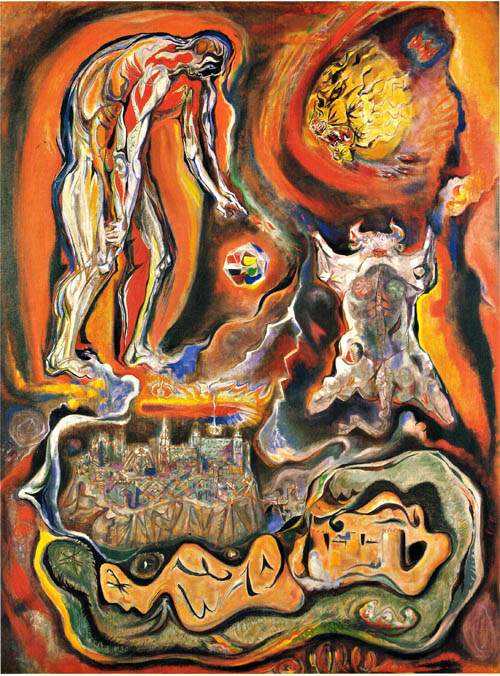
Goethe or the metamorphosis of plants
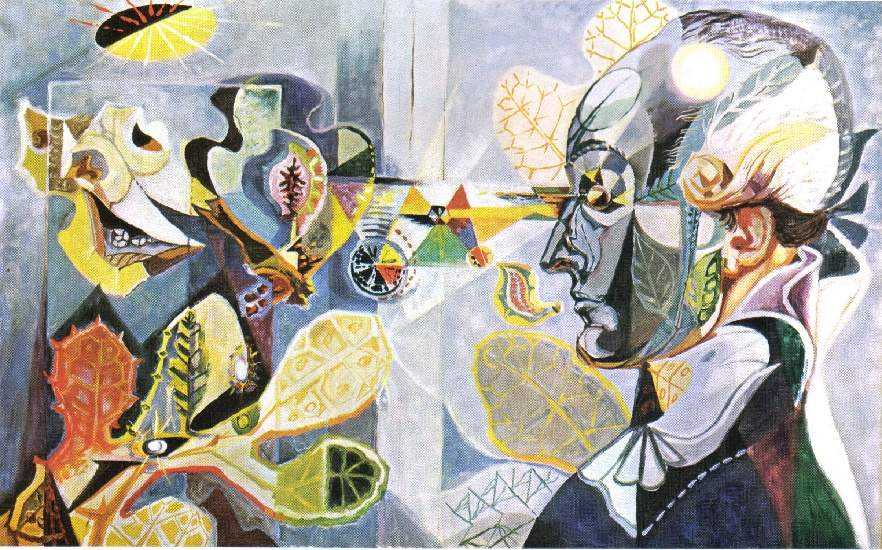
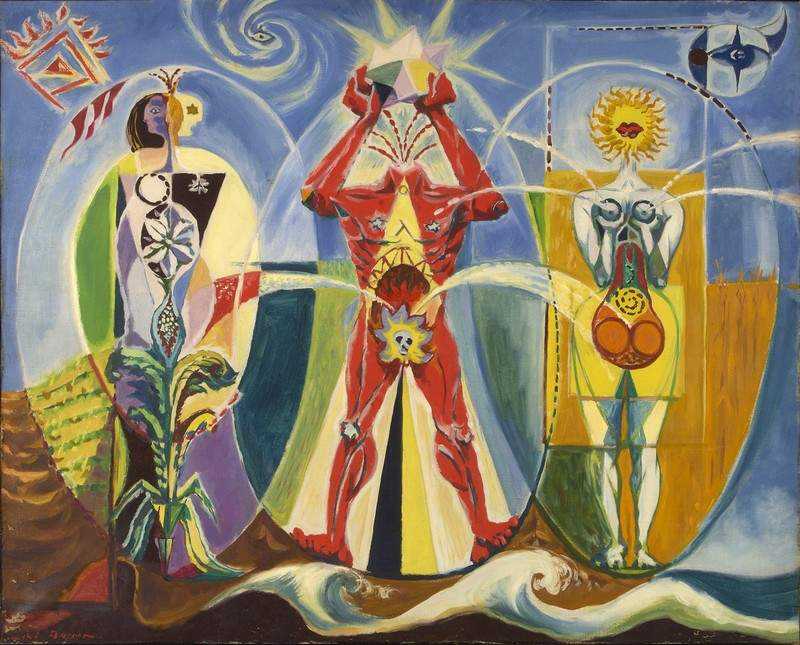
Gradiva
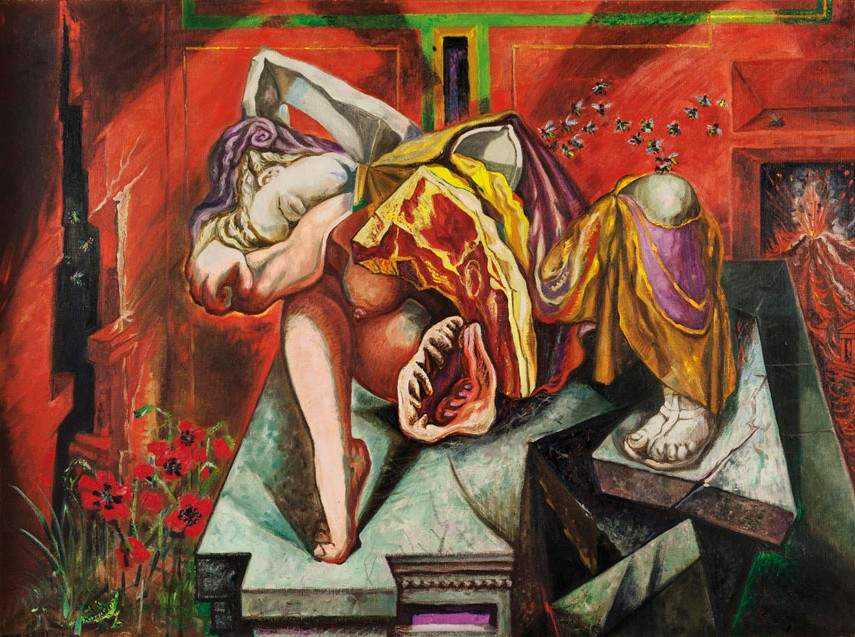
Portrait of the poet Kleist
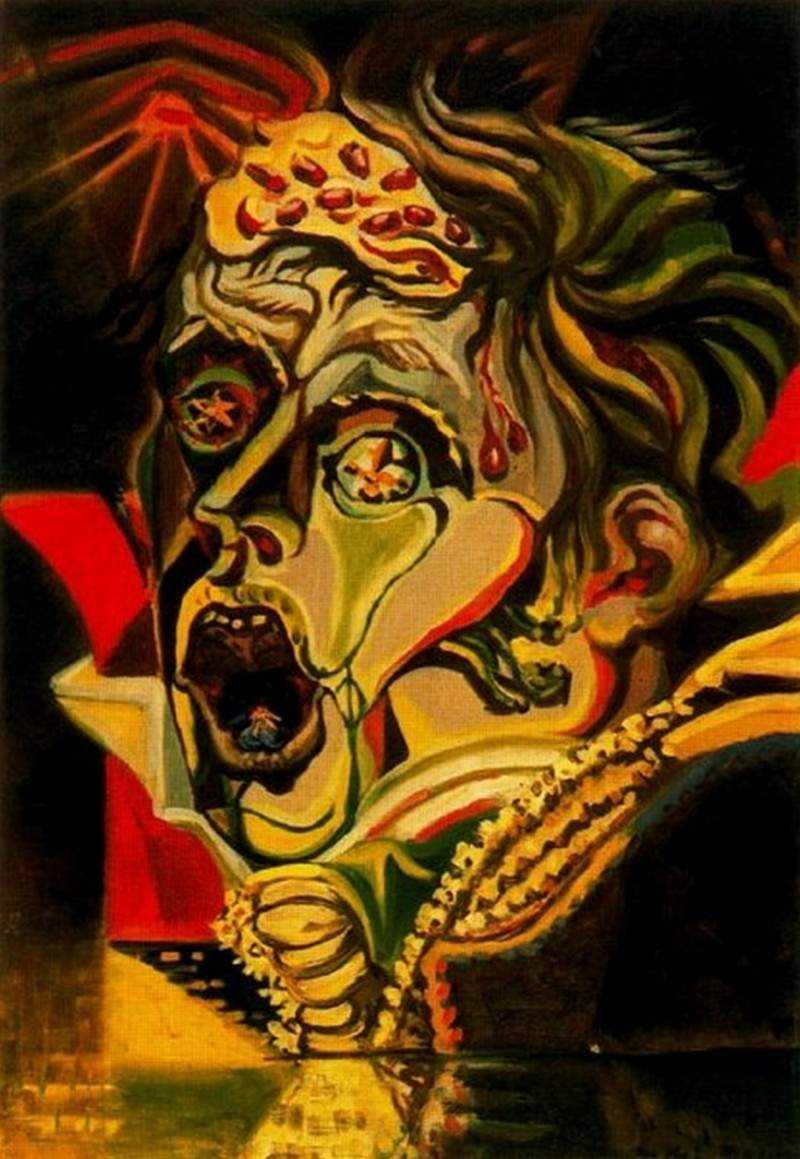
Removal
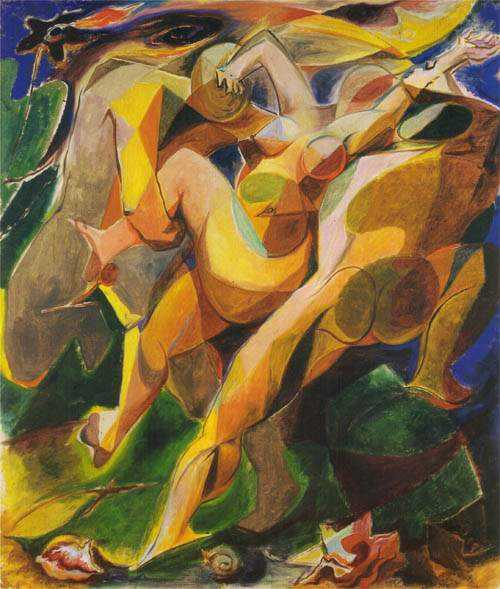
Returning from the execution

The Andalusian Reapers
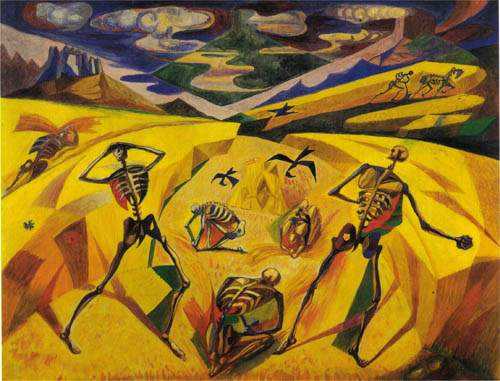
There is no world ended
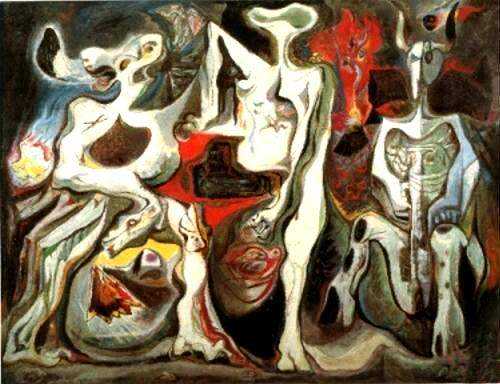
Tags:
- андре массон
- сюрреализм
Honors
In 1954, Masson received the Grand Prix National des Arts, a sign of official recognition, while he himself “opened up to the world”, making various trips until 1955 (mainly to Venice and Rome) and, until 1957, living in Paris intermittently.
In 1958, the filmmaker Jean Grémillon devoted a twenty-minute documentary to him, which was presented the following year at the Cannes Film Festival: André Masson et les Quatre Éléments.
The period of the Algerian war constitutes a parenthesis, his painting becoming violent and tormented again. Having retained his anti-militarist principles since his injuries in the First World War, he signed in 1960 the Manifesto of 121, a declaration on the right to insubordination. And in 1964, two years after the death of Georges Bataille, he wrote the obituary of his friend with a tortured temperament in the review of the Ecole des Chartes.
In 1965, André Malraux entrusted Masson with the decoration of the ceiling of the Odéon theater and various retrospectives of his work were organized: in 1964 in Berlin, in 1965 in Amsterdam (Stedelijk Museum) and in Paris (National Museum of Modern Art).
In 1969, he and his wife traveled a lot, especially in Germany. From that date on, he regularly went to the Bayreuth Festival.
In 1974, he recounts in his memoirs the impact of the war on his work.
In 1976, a retrospective exhibition was held at the Museum of Modern Art in New York, followed by another the following year, this time in Paris at the Grand Palais.
In 1979, following health problems, he gave up painting and devoted himself only to drawing.
On the night of October 27-28, 1987, he died at his Parisian home, 26, rue de Sévigné. He was found in the morning, “bedside lamp lit, his square hands with long and thin fingers holding an open book placed on his chest”. He and his wife are buried in the cemetery of Le Tholonet.
Gladys Masson, known as “Lily”, daughter of André Masson and Odette Cabalé (born in 1920 in Paris) became a painter.
Diego Masson (en) and Luis Masson, the sons of André Masson and Rose Maklès (born in June 1935 and September 1936 in Tossa de Mar), trained in music and theater respectively and married two of the daughters of the architect Fernand Pouillon, who designed the plans for the painter”s studio in Tholonet. Conductor trained by Pierre Boulez, Diego is also a composer and percussionist. During the Algerian war, he was a member of the Jeanson Network.
Alexis Masson (born in 1965 in Paris), painter and engraver, works in his grandfather”s studio in Tholonet.
More than 90 works of the artist are at the Centre national d”art et de culture Georges-Pompidou: 94 paintings, drawings, illustrations. His works can also be found at the Museum of Modern Art in New York, and at the Musée d”art moderne de la ville de Paris.











